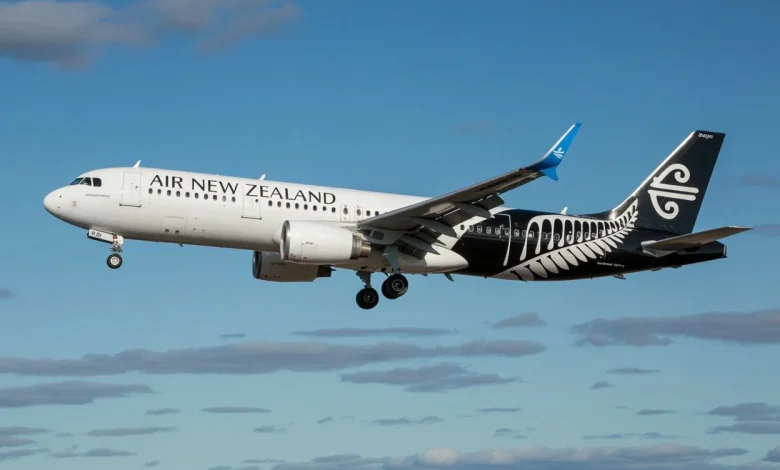Air New Zealand Flight NZ946 from Auckland to Avarua Makes Turnaround and Emergency Landing at AKL Airport, Several Passengers Stranded After Eight-Hour Nightmare

Published on
November 19, 2025
By: Tuhin Sarkar
Air New Zealand Flight NZ946, bound for Avarua from Auckland, was forced to make a dramatic turnaround after an unexpected eight-hour nightmare. Passengers aboard the flight experienced a harrowing ordeal when severe weather conditions in Avarua led to two failed landing attempts. With fuel running low, the crew made the crucial decision to return to Auckland, where an emergency landing took place. Several passengers were left stranded at Auckland Airport after the exhausting flight. The turnaround left many in distress, and now, Travel And Tour World urges you to read the entire story to uncover the shocking details of this unprecedented situation.
What was supposed to be a routine flight from Auckland to Avarua on Air New Zealand flight NZ946 turned into an eight-hour odyssey of uncertainty, confusion, and frustration for passengers aboard. On Wednesday, November 19, 2025, the flight was forced to return to Auckland after experiencing severe weather conditions in the Cook Islands capital, Avarua. This was not just another delay – it was a terrifying ordeal that caught everyone by surprise.
From the moment the Boeing 787-9 took off at 09:02 NZDT, the crew and passengers had no idea that their journey would take a drastic and unexpected turn. As the aircraft soared over the Pacific, the weather in Avarua was deteriorating rapidly. What seemed like a simple, straightforward flight soon became a nightmare as pilots made two failed attempts to land, forcing them to circle the skies. The relentless weather forced the crew to make the tough decision to turn around and head back to Auckland after eight hours of tension-filled uncertainty.
Severe Weather Conditions in Avarua: Wind Gusts Up to 28 Knots Make Landing Impossible!
The Deadly Winds That Nearly Doomed the Journey
The Cook Islands capital of Avarua was experiencing brutal weather conditions that day. Wind gusts reaching up to 28 knots wreaked havoc on the flight’s landing attempts. With no improvement in sight, the pilots found themselves in a critical situation. After the first failed landing attempt, the crew had no choice but to try again. Unfortunately, that too was unsuccessful.
The weather refused to cooperate, and the aircraft found itself stuck in a holding pattern at 4,000 feet for an agonising 30 minutes. With fuel reserves dwindling and no safe landing conditions on the horizon, the pilots made a crucial decision: it was time to head back to Auckland.
What Happens When Planes Turn Back: An Inside Look at Air New Zealand’s Quick Decision-Making
The Perils of Being Stranded in Mid-Air
When Air New Zealand flight NZ946 turned back to Auckland after a failed attempt to land in Avarua, it wasn’t just a routine decision. The pilots had to assess every potential risk to ensure the safety of everyone aboard. The flight crew had already completed two landing attempts, which were unsuccessful due to high winds and poor visibility. With deteriorating weather and a growing sense of urgency, the decision to return to Auckland was the only option left.
The Boeing 787-9 circled above the Pacific for nearly an hour, carefully burning fuel in a calculated move to maintain safety. This is a standard protocol for ensuring there is enough fuel for a safe return. Passengers, however, were left with no option but to trust the crew’s expertise as they endured the prolonged flight back to Auckland.
Stranded in Auckland: Air New Zealand’s Response to the Chaos
Passenger Rebooking and Accommodation Assistance Shows True Customer Care
Despite the challenging and frustrating situation, Air New Zealand stepped up its response. Upon landing back in Auckland, passengers were offered rebooking assistance and accommodation options. The airline’s swift and caring reaction ensured that people could continue their journeys, even though they had just experienced an eight-hour setback.
While no one had anticipated this disaster, Air New Zealand handled the crisis with professionalism, ensuring that affected passengers were not stranded without support. The airline acknowledged the inconvenience and promised to reschedule Flight NZ946 once conditions in Avarua improved. As soon as the weather in the Cook Islands cleared, the airline was ready to resume operations.
Why Air New Zealand’s Handling of the Situation Proves Their Commitment to Passenger Safety
A Company That Prioritises Safety Over Profit
At the heart of this experience was Air New Zealand’s commitment to the safety of its passengers. While many other airlines might have risked attempting a landing, Air New Zealand chose to prioritise the well-being of everyone on board. The decision to return to Auckland, despite the inconvenience, was the right one. In aviation, safety always comes first, and Air New Zealand proved that on this fateful flight.
Passengers were understandably frustrated, but they were also relieved to be in the hands of an airline that put their safety first. It’s a critical lesson in aviation safety: when the weather conditions are not conducive to landing, even the slightest risks are too great to take. The decision to turn back, though frustrating, ensured that everyone arrived back safely.
The Impact on Avarua and Its Tourism Industry: A Setback for the Cook Islands?
A Devastating Blow to the Cook Islands Tourism?
For the residents and businesses of Avarua, this incident presented a major setback. Avarua, which thrives on its tourism industry, relies heavily on international flights arriving safely and on time. Air New Zealand flight NZ946 was one of many flights that bring tourists to the Cook Islands. With the weather in such a dire state, it’s clear that not only did passengers suffer, but so did the local economy.
However, Air New Zealand’s handling of the situation should be commended. The flight may have turned back, but the airline’s quick action ensures that future flights to Avarua can resume once conditions improve. It’s a temporary setback, but the airline and the local tourism industry are hopeful for better days ahead.
The Bigger Picture: Aviation Safety and What We Can Learn from Flight NZ946
Aviation Safety: Why Weather Conditions Matter More Than Ever
This incident serves as a stark reminder of the critical role that weather plays in aviation. Air New Zealand flight NZ946 was a standard operation, but it turned into an intense example of how weather conditions can drastically affect flights. This is something passengers don’t always consider when booking their flights, but as the airline’s decision showed, safety must always be the number one priority.
While the frustration of being forced to turn back is undeniable, it’s important to realise that aviation safety protocols are designed to keep passengers safe, even when faced with unpredictable circumstances like severe weather. Flight NZ946 is a testament to how well-trained crews, solid decision-making, and swift communication can help mitigate risks and keep everyone safe in the most challenging of situations.
Lessons for Future Passengers: Why Your Flight May Be Delayed, and What You Can Do About It
Flight Delays Aren’t Always Airlines’ Fault: Weather Is a Key Factor
As passengers, it’s easy to get frustrated when flights are delayed or turned back, but it’s important to understand that weather conditions play a huge role. The weather isn’t something that airlines can control, and sometimes these events are unavoidable. While it’s easy to criticise the delays, it’s important to recognise that airlines, like Air New Zealand, are doing everything in their power to ensure safe travel. If a flight is delayed, turned back, or diverted, there’s a good reason for it.
For future passengers, it’s always best to remain calm and patient when faced with delays. Weather conditions can change rapidly, and the airline’s priority will always be to get you to your destination safely. Though delays can be frustrating, they are often necessary to prevent far worse outcomes.
Conclusion: A Flight Full of Surprises, but Safety Wins!
In the end, Air New Zealand flight NZ946 is a reminder of how unpredictable air travel can be. What started as a routine journey turned into a challenging eight-hour ordeal. But through it all, Air New Zealand demonstrated its commitment to passenger safety by making the right call. Despite the frustration and inconvenience, passengers were eventually safe, and the airline worked tirelessly to get them rebooked and accommodated. For future flights, passengers should always remember that safety comes first – no matter the cost.




